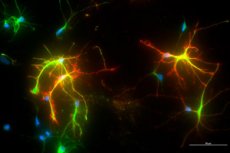New publications
Nanomaterial that mimics proteins could treat neurodegenerative diseases
Last reviewed: 02.07.2025

All iLive content is medically reviewed or fact checked to ensure as much factual accuracy as possible.
We have strict sourcing guidelines and only link to reputable media sites, academic research institutions and, whenever possible, medically peer reviewed studies. Note that the numbers in parentheses ([1], [2], etc.) are clickable links to these studies.
If you feel that any of our content is inaccurate, out-of-date, or otherwise questionable, please select it and press Ctrl + Enter.

A new nanomaterial that mimics the behavior of proteins could be an effective treatment for Alzheimer's and other neurodegenerative diseases. The nanomaterial alters the interaction between two key proteins in brain cells, which could have a powerful therapeutic effect.
The innovative results, recently published in the journal Advanced Materials, were made possible by a collaboration between scientists from the University of Wisconsin-Madison and nanomaterials engineers from Northwestern University.
The work focuses on altering the interaction between two proteins believed to be involved in the development of diseases such as Alzheimer's, Parkinson's and amyotrophic lateral sclerosis (ALS).
The first protein is called Nrf2, which is a specific type of protein called a transcription factor that turns genes on and off inside cells.
One of the important functions of Nrf2 is its antioxidant effect. Although different neurodegenerative diseases arise from different pathological processes, they are united by the toxic effect of oxidative stress on neurons and other nerve cells. Nrf2 fights this toxic stress in brain cells, helping to prevent the development of diseases.
Professor Jeffrey Johnson of the University of Wisconsin-Madison School of Pharmacy and his wife, Delinda Johnson, a senior research scientist at the same school, have been studying Nrf2 for decades as a promising target for treating neurodegenerative diseases. In 2022, the Johnsons and their colleagues discovered that increasing Nrf2 activity in a specific type of brain cell, astrocytes, helps protect neurons in mouse models of Alzheimer’s disease, leading to significantly reduced memory loss.
While previous research suggested that increasing Nrf2 activity could be the basis for treating Alzheimer's disease, scientists have had difficulty effectively targeting the protein in the brain.
"It's hard to get drugs into the brain, but it's also been very hard to find drugs that activate Nrf2 without a lot of side effects," says Jeffrey Johnson.
Now a new nanomaterial has arrived. Known as a protein-like polymer (PLP), the synthetic material is designed to bind to proteins as if it were a protein itself. This nanoscale mimic was created by a team led by Nathan Giannenchi, a professor of chemistry at Northwestern University and a member of the university’s International Nanoscience Institute.
Giannecchi has designed several PLPs to target different proteins. This particular PLP is designed to alter the interaction between Nrf2 and another protein called Keap1. The interaction of these proteins, or pathway, is a well-known target for the treatment of many conditions because Keap1 controls when Nrf2 responds to and combats oxidative stress. Under normal conditions, Keap1 and Nrf2 are associated, but when stressed, Keap1 releases Nrf2 to perform its antioxidant function.
"It was just in the course of a conversation that Nathan and his colleagues at Grove Biopharma, a startup focused on therapeutic targeting of protein interactions, mentioned to Robert that they were planning to target Nrf2," Johnson says. "And Robert said, 'If you're going to do that, you should call Jeff Johnson.'"
Soon, Johnson and Giannenchi were discussing the possibility of the University of Wisconsin-Madison lab providing the brain cells of mouse models needed to test Giannenchi's nanomaterial.
Jeffrey Johnson says he was initially somewhat skeptical of the PLP approach, given his unfamiliarity with it and the general difficulty of precisely targeting proteins in brain cells.
"But then one of Nathan's students came here and used it on our cells, and, damn, it worked really well," he says. "Then we really dug into it."
The study found that Giannecchi’s PLP was highly effective at binding to Keap1, freeing Nrf2 to accumulate in cell nuclei, enhancing its antioxidant function. Importantly, it did so without causing unwanted side effects that interfere with other Nrf2 activation strategies.
Although this work was done on cells in culture, Johnson and Giannecchi now plan to conduct similar studies on mouse models of neurodegenerative diseases, a line of research they hadn’t expected to pursue but are now excited to pursue.
"We don't have the expertise to do biomaterials," says Delinda Johnson. "So getting this from Northwestern and then further developing the biology side here at the University of Wisconsin shows that these kinds of collaborations are really important."
